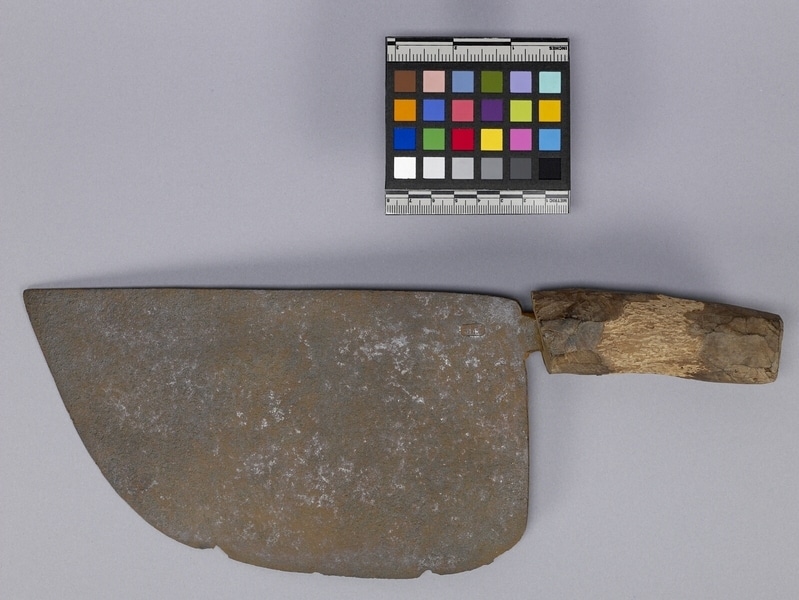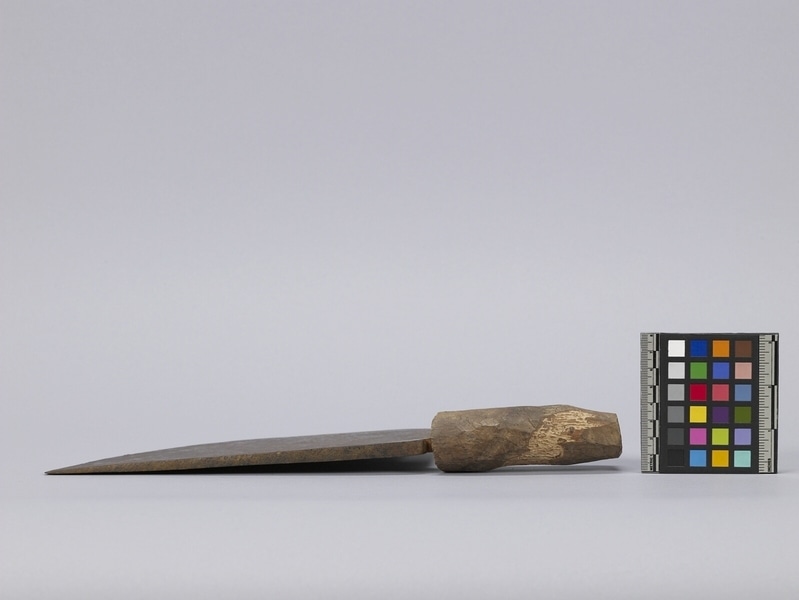Cleaver Item Number: Edz1105 from the MOA: University of British Columbia


Description
Rusted iron cleaver with a short, roughly cylindrical wooden handle; small rectangular stamp with two characters near top of blade at handle.
History Of Use
This cleaver was used for butchering a pig, either raw or cooked. Pork was and is a fundamentally important ceremonial food among both the Hakka and Cantonese original people of the New Territories of Hong Kong. Roasted pigs are offered to important lineage ancestors, and then divided and eaten, primarily by men, after the ceremony. Pieces of cooked pork are offered to closer ancestors, including the recently-deceased. Pieces of pork were and to some extent still are given by married-out daughters to their natal families when they return to them for visits at festivals. Large and wealthy Cantonese lineages in the New Territories place great emphasis upon the ceremonial division of pork among men of the lineage. Pork is also used in the worship of gods (with the exception of Buddhist deities), and the consumption of pork that has been used in this worship is said to be beneficial. After the mid-twentieth century the New Territories of Hong Kong began to undergo fundamental changes. The people who had been settled there before 1898, when the British colonizers claimed the area, began to give up rice agriculture and coastal fishing, turning instead to wage labour and increased employment overseas. By the end of the century, educational opportunities leading to the possibility of white-collar work also increased, together with western influences. These changes meant that objects and clothing once useful and appropriate were no longer needed and generally were discarded. Some were saved by their owners, who sometimes were willing to donate them to museums, sharing, also, their knowledge of how they were made and used. Cleavers of this type, however, are still in active use by villagers, as well as by pork butchers. It differs from the standard household cleaver, which is the only knife used in food preparation, in its curved blade.
Narrative
This cleaver, and many other objects in this collection, was collected from the abandoned agricultural village of Tsing Fai Tong, in Tsuen Wan District, Hong Kong. The village, like many others in remote and mountainous areas of Hong Kong, had been abandoned because life there was not economically viable in contemporary Hong Kong. Its former inhabitants, members of the Fu lineage, had moved down to the coastal area of Sham Tseng. Elizabeth Johnson collected the objects from the ruined houses with the permission of the Fu lineage, who donated them to the Museum of Anthropology through the intercession of the District Officer, James Hayes. As Hong Kong’s New Territories modernized it was common for people to discard objects that were no longer useful. It appears that the blade of this cleaver was purchased from a specialist, whereas the handle was made by the owner or a representative of the Fu lineage. Hakka people are one of the two original land-dwelling groups that settled the area that became the New Territories of Hong Kong. Their spoken language, and some customs, differed from those of the other original group, the Cantonese or Punti. The Cantonese arrived first and settled on the best rice-growing lands, while the Hakka began to arrive after the late 17th century and settled the more hilly lands.
Item History
- Made in Tsuen Wan, Hong Kong, China
- Collected by Elizabeth L. Johnson during 1979
- Owned by Elizabeth L. Johnson before March 17, 1980
- Received from Elizabeth L. Johnson (Seller) and Museum of Anthropology Shop Volunteers (Funding source) on March 17, 1980
What
- Name
- Cleaver
- Identification Number
- Edz1105
- Type of Item
- cleaver
- Material
- iron metal and wood
- Manufacturing Technique
- cut and smoothed
- Overall
- height 4.0 cm, width 13.0 cm, depth 34.0 cm
Who
- Culture
- Chinese: Hakka
- Field Collector
- Elizabeth L. Johnson
- Previous Owner
- Elizabeth L. Johnson
- Received from
- Elizabeth L. Johnson (Seller) and Museum of Anthropology Shop Volunteers (Funding source)
Where
- Holding Institution
- MOA: University of British Columbia
- Made in
- Tsuen Wan, Hong Kong, China
When
- Collection Date
- during 1979
- Ownership Date
- before March 17, 1980
- Acquisition Date
- on March 17, 1980
Other
- Item Classes
- metalwork
- Condition
- fair
- Accession Number
- 0610/0075